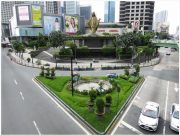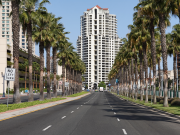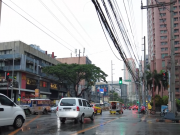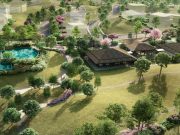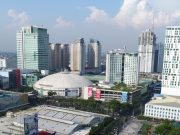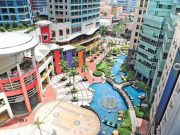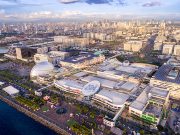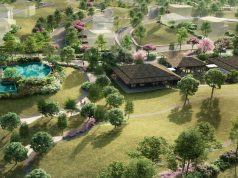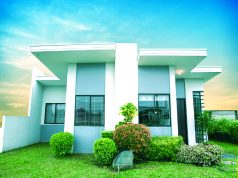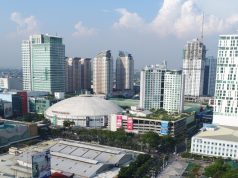If you’re seeking a lucrative return on your real estate investment, the Philippines warrants serious consideration. This nation boasts a rapidly advancing economy and a growing population of emerging professionals, resulting in vast potential for those targeting the real estate market. With a discerning eye, you can secure properties that guarantee impressive returns now and in the future. Keep reading to discover what to consider when investing in this high-potential market.
The Philippine real estate industry has experienced significant growth over the years and has played a crucial role in the country’s economic development.
1. Historical Trends:
The Philippine real estate industry has witnessed substantial growth concerning investments, construction activities, and property values. Here are some key trends:
A. Booming Residential Sector
The residential sector in the real estate industry in the Philippines has experienced significant improvement over the past decade, driven by several factors:
| • | Increased housing supply due to developers constructing more residential units; |
| • | Urbanization and migration led to the development of more housing projects; |
| • | Affordable housing programs put in place by the government; |
| • | Infrastructure initiatives opening up new areas for residential development; |
| • | More flexible financing options offered by financial institutions; and |
| • | Upscale preferences of a growing middle class. |
In March 2023, BusinessWorld revealed that the Residential Real Estate Price Index (RREPI) experienced a significant surge of 7.7% in the fourth quarter of 2022, as the Bangko Sentral ng Pilipinas (BSP) reported. It marks a noteworthy increase from the 6.5% growth observed during the third quarter and a 4.9% rise compared to the same period in 2021.
In the urban areas, there’s a growing demand for residential properties due to a rising population, urbanization, and a growing middle class. Developers focus on mixed-use neighborhoods offering a variety of spaces like residential, commercial, and retail. These developments cater to different segments – affordable housing, mid-range condos, and luxury properties. The market shift towards more diverse options reflects changing homebuyer preferences.
B. Rise of Office Spaces
Several factors have contributed to the increased demand for office spaces in the Philippines:
| • | Business Process Outsourcing (BPO) has driven office space demand, as large workspaces are essential to their operations; |
| • | the rise of Offshore Gaming Operators in the country; and |
| • | Co-working and Flexible Workspaces have increased in popularity among startups, freelancers, and small businesses due to their affordability, networking opportunities, and flexible lease terms. |
Despite the economic challenges brought on by the pandemic, the BPO industry in the Philippines has continued to experience consistent growth since 2016, based on JLL’s research last May. The industry’s earnings and employment rate have increased, with a Compound Annual Growth Rate (CAGR) of 4.6% in 2022, according to the IT and Business Process Association of the Philippines (IBPAP).
C. Retail and Commercial Developments
The Philippines is experiencing a surge in retail and commercial developments. Several reasons contribute to this trend:
| • | As the middle class grows, modern shopping experiences and increased mall and commercial center development follow due to higher disposable incomes and preferences. |
| • | Urbanization has necessitated increased retail and commercial spaces to meet the needs of a growing population, and |
| • | The tourism industry is also driving demand for more retail and commercial spaces in tourist hotspots. |
Prime commercial locations remain attractive to businesses, especially in the food and beverage (F&B) sector, despite the impact of COVID-19. According to The Manila Times, the F&B industry is experiencing a much-needed boost – thanks to recent technological advancements.
Late last year, sales began to recover, and now the sector is projected to reach a three-year high of USD 9.3 billion with a 12% YoY increase.
D. Industrial Sector
Modernizing warehouses, constructing more cold storage, and exploring flexible options are crucial to maximizing opportunities in the warehousing sector in the Philippines, according to a 2020 report by Colliers. The sector represents 31% of the total gross value added in transportation and storage, underscoring its significance to the economy during that period.
Although the Philippines is predominantly urban, there are still restrictions on available industrial space. Nonetheless, the industrial sector continues to play a crucial role in warehousing, logistics, and light manufacturing, with an apparent steady growth in the demand for warehouse and storage facilities due to several factors:
| • | E-commerce growth has increased demand for storage facilities as more businesses move online to meet customer needs. The trend owes itself to enhanced internet access, the convenience of online shopping, and digital marketing. |
| • | Retail expansion, both online and offline, requires additional warehousing and storage space. Maintaining product availability involves inventory management with growing business chains and new storefronts. |
| • | Logistics and supply chain growth in the Philippines lead to mounting demand for strategically located warehouse and storage facilities, as businesses prioritize efficient distribution and timely delivery of goods. |
| • | Manufacturing and industrial sectors require storage facilities to support raw materials, work-in-progress inventory, and finished goods. As these activities expand, so does the need for storage. |
| • | Foreign investors can leverage to expand their operations in the country with the emergence of top Philippine e-commerce platforms, sequentially creating a need for warehouse and storage facilities. |
2. Effects on Economic Growth:
The real estate industry is crucial for the Philippine economy, with far-reaching impacts across the country.
A. Contribution to GDP
The real estate industry in the Philippines contributed a staggering 536.44 billion pesos (≈USD 9.5 billion) to the national economy in 2022.
B. Job Creation
The real estate industry has been a significant source of employment in the Philippines. It has created numerous job opportunities in construction, property development, property management, sales, and related industries. In 2020, the real estate, renting, and business activities sector employed more than 97,000 individuals.
C. Infrastructure Development
A significant contribution to economic growth, the first quarter of 2022 experienced a 1.8% uptick in approved building permits due to infrastructure development and construction of residential/non-residential buildings. These developments amount to 86.78 billion pesos (≈USD 1.5 billion).
In retrospect, government initiatives towards the transportation infrastructure, such as the Metro Manila Subway project, the expansion of road networks, and the enhancement of mass transit systems, can positively impact the real estate industry. Enhanced connectivity can increase the attractiveness of specific areas for development, leading to potential growth in property values.
D. Approved Investments
Approved investments in the country from Jan to Mar 2023 totaled 480.36 billion pesos (≈USD 8.5 billion), allocating 1.7% to real estate activities, providing a welcome boost to the economy, increasing employment opportunities, and promoting construction activities.
It’s worth noting that multiple factors, including governmental policies, economic fluctuations, and external events, can influence the real estate market in the Philippines.
Invest in Stable, Profitable Properties Across the Country
1. Metro Manila
Metro Manila has gained ground in the Emerging Trends in Real Estate Asia Pacific 2023, placing 16th among 22 cities according to a report by Urban Land Institute and PricewaterhouseCoopers published in BusinessWorld last January.
Taguig City
A highly desirable location for real estate investment in the metro, Taguig City is known for its rapid residential developments and modern commercial infrastructures. Here are some key reasons why Taguig City is an excellent choice:
- Accessibility
Taguig City enjoys excellent connectivity, making it convenient for residents and investors. It is situated near major highways, including the Metro Manila Skyway (Skyway) and Carlos P. Garcia Avenue (C5 Road), and is easily accessible from different parts of Metro Manila. The city is also close to the Ninoy Aquino International Airport, providing easy access for international travelers.
- Lifestyle and Amenities
Offering a modern and cosmopolitan lifestyle, Taguig City is home to numerous high-end restaurants, trendy bars, and luxurious shopping malls. The city also features recreational parks, golf courses, and sports facilities, catering to the diverse interests of its residents.
- Education and Healthcare
Taguig City has excellent education options. International schools like The Beacon School, British School Manila, and others offer top-notch education to a diverse student population. Taguig also has public and private colleges and universities, such as Taguig City University and Enderun Colleges. Over 50 schools in the area ensure children have access to quality education, with some, including Taguig Science High School and Senator Rene Cayetano Science and Technology High School, focusing on science and technology and providing specialized learning opportunities to students.
Boasting world-class hospitals and medical centers, including St. Luke’s Medical Center and Medical Center Taguig, these outstanding facilities in Taguig City provide access to quality medical services, advanced treatments, state-of-the-art facilities, and highly skilled healthcare professionals.
The availability of reputable educational institutions and top-notch healthcare facilities in Taguig City reflects its commitment to providing its residents with quality education and healthcare services.
- Investment Potential
Real estate in Taguig City has shown steady appreciation over the years due to its status as a prime business and commercial hub in the metro; hence the demand for commercial properties in Fort Bonifacio Global City remains high. Investing in Taguig City offers the potential for long-term returns and rental income.
- Master-Planned Communities
Taguig City features master-planned residential communities that provide well-designed and secure living environments. These developments often offer exclusive amenities such as swimming pools, fitness centers, and landscaped gardens, providing residents with a comfortable and luxurious lifestyle.
- Sustainable Development
Taguig has implemented sustainable development initiatives, including environmental conservation, green buildings, and office spaces. This focus on sustainability contributes to a healthier and more livable city.
According to the Green Building Information Gateway (GBIG) website, there have been a total of 58 certifications issued by the Leadership in Energy and Environmental Design (LEED) in Taguig City. Among these certifications, commercial properties in the Fort Bonifacio Global City (BGC) area, like the Finance Centre and High Street South Corporate Plaza, have both achieved LEED Gold Certifications. LEED Gold Certification is a prestigious recognition that signifies a high level of sustainability and environmentally friendly practices implemented in these buildings.
| Bonifacio Global City (BGC)Taguig City is home to Bonifacio Global City, a dynamic business and lifestyle district. It offers many residential options, from luxury condominiums to upscale houses. The area boasts state-of-the-art office buildings, world-class shopping centers, and a vibrant dining and entertainment scene. |
Makati City
Makati City is a highly coveted real estate investment destination, distinguished by its towering skyscrapers, luxurious condominiums, and commercial centers. Its reputation as the bustling central business district of Metro Manila, coupled with access to cosmopolitan lifestyle amenities and a secure rental market, sets it apart. Several leading mixed-use developments offer a comprehensive live-work-play environment with hassle-free access to first-rate shopping, dining, entertainment, and business facilities.
Moreover, these developments often feature well-designed public spaces, landscaped gardens, and recreational facilities, which make them even more attractive. Investing in properties within these mixed-use developments presents potential benefits and registers several advantages that make it an attractive choice:
- Central Business District
Makati is considered one of the premier business districts in Metro Manila, hosting numerous multinational corporations, financial institutions, and major companies. This vibrant business environment creates a high demand for office space rentals, making Makati an ideal location for commercial real estate investments.
- Secure Rental Market
The thriving business sector in Makati contributes to a robust rental market. The city attracts local and international professionals seeking employment opportunities, leading to a continuous demand for residential properties, particularly condominiums. Real estate investors can benefit from stable rental income and potential capital appreciation.
- Infrastructure and Amenities
The commercial district of Makati City is well-developed and offers a wide range of amenities and infrastructure. It boasts modern shopping centers, upscale dining establishments, entertainment venues, and cultural attractions. Additionally, the city has reliable utilities, efficient transportation systems, and access to healthcare facilities, making it an appealing location for both residents and businesses.
- High Property Value
The neighborhoods of Makati including Bel-Air, San Lorenzo, Salcedo, and Legaspi are known for their prime real estate and prestigious addresses. Properties in the city tend to hold their value well and have the potential for long-term appreciation. Investing in Makati can offer the opportunity for capital gains, particularly in sought-after areas such as the central business district or prime residential neighborhoods.
- Strong Security and Governance
Makati City has implemented effective security measures and is known for its well-maintained infrastructure and cleanliness. The local government’s efforts in maintaining the city’s reputation as a safe and well-managed business hub contribute to its attractiveness as an investment location.
| Among the notable mixed-use developments in Makati City include Ayala Center, Rockwell Center, and Century City. Ayala Center is a sprawling complex featuring luxury hotels, office buildings, residential condominiums, and retail malls. Rockwell Center offers upscale residential towers, high-end retail spaces, office buildings, and amenities, while Century City is notable for its innovative design featuring commercial spaces, residential condominiums, and a retail mall. |
Quezon City
Offering a large consumer base, thanks to its dense population, Quezon City continues to experience economic growth and urban development. Investing in real estate in prominent districts of Quezon City provides opportunities for rental income, capital appreciation, and potential returns on investment. The city offers several factors that make it an attractive choice for investors:
- Large Consumer Base
Boasting a dense population, Quezon City is making a significant consumer market. It presents opportunities for various real estate ventures, such as residential developments, retail spaces, and commercial establishments. The sizable consumer base provides a potential customer pool for businesses and rental properties, enhancing the prospects for returns on investment.
- Economic Growth
Quezon City has been experiencing continuous economic growth, driven by various sectors such as BPO, manufacturing, education, and healthcare. This growth translates into increased employment opportunities, higher disposable incomes, and a considerable demand for housing and commercial spaces. Investing in real estate within this thriving economic environment can yield favorable returns and income generation.
- Urban Development
Quezon City is undergoing significant urban development, with ongoing infrastructure projects and improvements. It includes transportation upgrades, road expansions, and the development of mixed-use communities. These efforts enhance connectivity, accessibility, and complete livability, making the city more attractive for real estate investments.
- Rental Income Potential
With its diverse population, many universities, and thriving businesses, Quezon City presents prime opportunities for real estate investment. Residential properties close to education and employment hubs offer investors the potential for long-term growth and a steady rental income. Consider the city as a strategic location for your next investment.
- Capital Appreciation
The continued economic growth and urban development in Quezon City can lead to capital appreciation of real estate properties over time. As the city continuously evolves and transforms, it presents a promising opportunity for property value appreciation, resulting in long-term gains.
| Quezon City, the largest city in the Philippines, offers a large consumer base and economic growth opportunities for investors in the real estate market. One prime location for investment is Araneta City in Cubao, which serves as a hub for business, entertainment, and residential developments. It is easily accessible through major thoroughfares and the MRT-3 line. Eastwood City in Bagumbayan, a master-planned township, is another excellent option for investment due to its combination of residential, commercial, and retail elements. UP Technohub in Diliman is known for its prestigious educational institutions and government offices and also presents many investment opportunities for its proximity to these locations. Meanwhile, Vertis North is a mixed-use development that offers a transportation hub, office buildings, retail shops, Ayala Malls Vertis North, and residential spaces. Its strategic location near EDSA enhances its connectivity and accessibility. With these varied investment options, Quezon City presents a promising destination for real estate investors seeking to grow their portfolios. |
16 Industries Reaching New Heights: The 2022 Regional Accounts of the Philippines (RAP)
The Philippine economy experienced growth in all 17 regions in 2022, with Western Visayas leading at 9.3%. Overall GDP grew by 7.6%, and all 16 industries reported a positive increase, with real estate and dwellings up 5.3%. These figures come from the 2022 Regional Accounts of the Philippines, released by the Philippine Statistics Authority on 27 April 2023.
For a complete overview of time series charts, tables, and data visuals for the RAP, check www.psa.gov.ph/regional-accounts.
2. Northern Luzon
Provinces and cities in Northern Luzon offer potential opportunities for real estate investment. Here are some notable locations:
La Union
Located along the western coast of Northern Luzon, La Union has gained attention as a beach and surf destination. The province offers a relaxed coastal lifestyle, attracting both tourists and locals. Real estate opportunities in La Union include beachfront properties, resorts, and residential developments. The potential for growth in tourism and the demand for vacation rentals make La Union an enticing investment option.
Ilocos Norte
Laoag is another promising area for real estate investment in Northern Luzon. It is known for its rich cultural heritage, historical sites, and picturesque landscapes. The province has been actively promoting tourism, luring visitors to marvel at iconic landmarks like the beautiful and historic Paoay Church; or experience the thrill of the dunes of Paoay and La Paz. Real estate ventures in Ilocos Norte can capitalize on the demand for accommodations, resorts, and heritage-themed properties in Pagudpud.
Pangasinan
A province with a diverse economy, Pangasinan encompasses agriculture, aquaculture, and tourism. The city of Dagupan in Pangasinan, in particular, is a major urban center and economic hub in the region. Real estate opportunities in Alaminos, Pangasinan, include residential developments, commercial spaces, and agricultural properties. The province’s accessibility, growing economy, and potential for future infrastructure projects make it an attractive investment location.
Northern Luzon has been experiencing notable economic growth in recent years. This region, comprising several provinces, has contributed significantly to the country’s overall economic development. Here are some key aspects of Northern Luzon’s economic growth:
- Agriculture and Agribusiness
Northern Luzon’s fertile lands and favorable conditions make it a major producer of rice, corn, veggies, and fruits. The agricultural sector supports local consumption and export industries, while agribusiness adds value to products and boosts employment.
- Tourism and Hospitality
Northern Luzon boasts diverse natural attractions, cultural heritage sites, and scenic landscapes, making it a popular tourist destination. The region is home to stunning beaches, mountain ranges, historical landmarks, and vibrant festivals. Popular destinations include Baguio City, the beaches of La Union and Pangasinan, the UNESCO World Heritage Site of Vigan, and the natural wonders of Sagada and Banaue. The Ilocos region’s economic growth has spurred investments in accommodations, restaurants, recreational facilities, and other tourism-related businesses.
- Industrial and Manufacturing
Northern Luzon has witnessed the development of industrial and manufacturing activities. This includes manufacturing plants, factories, and processing facilities in various sectors such as textiles, garments, electronics, and food processing. Cities like Baguio, Laoag, and San Fernando have seen the establishment of industrial zones and business parks, attracting both local and foreign investors.
The Baguio City Economic Zone, home to 44 companies in diverse industries, is a thriving industrial center that has a profound impact on the exports of the Cordillera region. Not only does this industrial hub generate economic growth, but it also creates job opportunities for individuals with varying backgrounds and skill sets. As a crucial contributor to local employment, BCEZ plays a crucial role in supporting industrial development in the region.
- Infrastructure Development
The government has been focusing on infrastructure development in Northern Luzon to enhance connectivity and facilitate economic growth. This includes the construction and improvement of roads, bridges, airports, and seaports, as well as the expansion of telecommunications networks. These infrastructure projects contribute to the region’s accessibility, trade facilitation, and overall business environment.
3. South Luzon
CALABARZON, also known as Region IV-A, is an administrative region in the Philippines that encompasses the provinces of Cavite, Laguna, Batangas, Rizal, and Quezon. This region located in South Luzon is known for its dynamic real estate market and growing economic opportunities. Here’s an overview of the real estate sector in CALABARZON:
- Residential Developments
With a wide range of residential properties in Laguna and Batangas areas catering to different market segments, these provinces within the region have witnessed the development of various housing projects, including subdivisions, condominium complexes, townhouses, and low-cost housing initiatives. These properties accommodate the increasing housing demand; driven by population growth, urbanization, and the region’s proximity to Metro Manila.
- Industrial Zones
CALABARZON has several industrial zones, making it an attractive destination for manufacturing investments. Its strategic location, infrastructure connectivity, and available land contribute to the establishment of factories and warehouses. Laguna Technopark near the commercial districts of Sta. Rosa and Biñan, Cavite Economic Zone, and Batangas Port Industrial Parks offer opportunities for industrial real estate investments.
- Commercial Centers
As CALABARZON experiences economic growth, the demand for commercial spaces, retail establishments, and office buildings has increased. The region has seen the development of shopping malls, retail centers, and business districts, catering to the growing consumer market and business activities. Major cities like Imus, Biñan, and Batangas City have commercial areas that attract local and foreign investors.
- Tourism and Leisure
Offering various tourist destinations and recreational areas, CALABARZON has become an increasingly popular spot for visitors. Recreational parks in Tagaytay near the residential districts of Cavite, the beaches of Batangas, and the historical sites in Rizal offer opportunities for real estate ventures in the tourism and leisure sector. Investments in hotels, resorts, vacation rentals, and leisure facilities are notable in these areas.
- Infrastructure Development
Significant infrastructure development, including new roads and transportation networks, has improved accessibility and connectivity in CALABARZON and strengthened the region’s investment environment. More than 1,300 infrastructure projects were completed in 2021, advancing transportation initiatives like road construction and highway expansion.
4. MIMAROPA
MIMAROPA, an administrative region in the Philippines, consists of four provinces: Mindoro (divided into Occidental Mindoro and Oriental Mindoro), Marinduque, Romblon, and Palawan. The real estate industry in MIMAROPA is diverse and influenced by the region’s natural beauty, tourism potential, and economic activities. Here’s an overview of the real estate sector in each province:
Occidental Mindoro and Oriental Mindoro
Mindoro is divided into two provinces: Occidental and Oriental. These provinces offer real estate opportunities for residential, commercial, and agricultural interests. Occidental is known for its farming, while Oriental’s coastal areas are suited for beachfront development. Puerto Galera and Calapan are popular tourist spots in Oriental Mindoro, offering investment opportunities in resorts, vacation rentals, and other hospitality ventures.
Marinduque
An island province is known for its natural attractions, including beaches, mountains, and coral reefs. The real estate industry in Marinduque revolves around tourism and leisure. The town of Boac, the capital of Marinduque, has historical and cultural significance, providing opportunities for heritage-themed properties. The coastal areas of Marinduque, such as Gasan and Buenavista, offer potential for beachfront resorts and residential properties.
Romblon
An archipelagic province composed of several islands known for its marble industry, pristine beaches, and dive sites. The real estate market in Romblon is still developing but offers opportunities for tourism-related investments, such as resorts, vacation rentals, and diving centers. The town of Romblon, the provincial capital, is a potential hub for commercial and residential developments while other islands, like Tablas and Sibuyan, have their unique charms for real estate ventures.
Palawan
One of the most sought-after tourist destinations in the country, Palawan is renowned for its stunning landscapes, biodiversity, and pristine beaches. The real estate industry in Palawan is vibrant, catering to local and international investors. The province offers abundant real estate opportunities, including luxury resorts, eco-tourism developments, residential properties, and commercial spaces. Areas like Puerto Princesa, El Nido, and Coron have seen significant real estate investments due to their popularity among tourists.
5. Central Luzon
Comprising seven provinces: Aurora, Bataan, Bulacan, Nueva Ecija, Pampanga, Tarlac, and Zambales, Central Luzon region covers a total land area of 21,470 square kilometers and is home to several thriving cities and industrial zones. Here’s an overview of the real estate developments in Central Luzon:
- Residential Developments
Central Luzon offers a variety of residential properties catering to different market segments. Urban areas such as Angeles City, San Fernando, and Tarlac City have residential subdivisions, condominiums, and townhouse projects. The availability of land and the region’s proximity to Metro Manila makes it an attractive choice for individuals and families looking for affordable housing options.
- Industrial and Commercial Centers
The cities of Angeles and Mabalacat in Pampanga are home to industrial and commercial centers, encompassing Freeport zones that attract investments and offer business-friendly environments. These areas are characterized by industrial parks, logistics hubs, and manufacturing facilities, making them highly suitable for industrial real estate developments.
- Tourism and Leisure
Central Luzon boasts several tourist destinations and leisure spots. The region is a dwelling place for historical sites, cultural landmarks, and natural attractions. Places like Baler in Aurora, Mount Pinatubo in Zambales, and the heritage city of Malolos in Bulacan draw both local and international tourists. Real estate developments in the tourism and leisure sector include hotels, resorts, and vacation rentals, catering to the growing demand for accommodations and recreational facilities.
- Infrastructure Development
The completion of the North Luzon Expressway (NLEX) and the Subic-Clark-Tarlac Expressway (SCTEX) has improved transportation links, connecting the region to Metro Manila and neighboring provinces. These infrastructure developments contribute to the region’s attractiveness for real estate investments, as they facilitate the movement of goods, services, and people.
- Educational Institutions
Central Luzon is home to several universities and educational institutions, including Central Luzon State University (CLSU) – the largest university in the region – making it a destination for students from within the region and neighboring areas. The presence of educational institutions has spurred real estate developments, such as student dormitories, apartments, and commercial spaces targeting the student population.
6. Visayas
The Visayas region in the Philippines offers several valuable real estate locations that attract investors and offer potential returns. Here are some of the most valuable real estate areas in the Visayas:
Cebu City
The regional center of the Visayas, Cebu City is one of the most developed cities outside Metro Manila. It offers a thriving real estate market with high demand for residential, commercial, and office spaces. The city’s strategic location, modern infrastructure, and vibrant economy make it an attractive investment destination. Cebu Business Park and Ayala Center Cebu are desirable locations for luxurious condominiums, vibrant commercial centers, and business districts.
Mactan Island
Located near Cebu, the island of Mactan is a popular tourist destination and a hub for resort and residential developments. The island is known for its beautiful beaches, diving spots, and luxury resorts. Real estate investments in Mactan Island focus on beachfront properties, high-end residential projects, and resort-style condominiums. The area’s proximity to the international airport and its tourism potential make it a valuable real estate location.
Bacolod City
The capital of Negros Occidental, Bacolod City, is known as the “City of Smiles” and an urban center in the Visayas. It has a growing real estate market, with demand for residential and commercial properties. The city offers a mix of modern developments, shopping centers, and commercial spaces, with residential subdivisions and condominium projects. Bacolod City’s vibrant culture, business opportunities, and urban amenities make it an attractive investment option.
Iloilo City
Iloilo City, located on the island of Panay, is a rapidly developing urban center in the Visayas. It is known for its rich cultural heritage, culinary scene, and economic growth. The city offers a range of real estate opportunities, including residential properties, commercial spaces, and mixed-use developments. Areas like Iloilo Business Park have seen significant real estate investments, featuring high-rise condominiums, office buildings, and lifestyle centers.
Bohol
Known for its pristine beaches, scenic landscapes, and the famous Chocolate Hills, the real estate developments in Bohol focus on beachfront resorts, vacation rentals, and eco-tourism projects. Areas like Panglao Island, Alona Beach, and Tagbilaran City attract local and foreign investors due to the island’s natural beauty and tourism potential.
7. Cordillera Administrative Region
The Cordillera Administrative Region (CAR) is known for its unique geography, rich cultural heritage, and breathtaking landscapes. The region comprises six provinces: Abra, Apayao, Benguet, Ifugao, Kalinga, and Mountain Province, as well as the highly urbanized city of Baguio.
Baguio City
Known as the “Summer Capital of the Philippines,” Baguio City is a popular tourist destination and a thriving urban center in the Cordillera Region. Its cool climate, scenic views, and vibrant culture make it an attractive location for residential and vacation properties. Investing in real estate in Baguio City can cater to the tourism industry, as well as the growing demand for second homes and retirement residences. Other areas like Sagada in Mountain Province and Bontoc in Kalinga also offer the potential for tourism-related real estate ventures. Here’s an overview of the real estate industry in the Cordillera Administrative Region:
- Residential Properties
The real estate market in the CAR offers a range of residential properties catering to different preferences and budget ranges. Urban areas like Baguio City and Benguet’s capital, La Trinidad, have residential subdivisions, condominium projects, and townhouse communities. The cool climate, scenic views, and peaceful environment of the Cordillera region attract individuals and families seeking a serene lifestyle.
- Agricultural Land and Farming
The Cordillera region is predominantly agricultural, with fertile lands suitable for farming and agriculture-related activities. The region’s terraced rice fields in Ifugao, famously known as the Banaue Rice Terraces, are a UNESCO World Heritage Site and a significant attraction. Agricultural land in the Cordillera region presents opportunities for investors interested in agricultural development, organic farming, or eco-tourism projects centered around traditional farming practices.
- Commercial and Retail Spaces
Urban centers in the Cordillera region, particularly Baguio City and La Trinidad, have a growing commercial and retail sector. The demand for commercial spaces, office buildings, and retail establishments has increased as the region experiences economic growth. These areas serve as commercial hubs, offering opportunities for retail businesses, banks, restaurants, and service-oriented establishments.
The Philippine real estate industry is experiencing rapid growth, with numerous opportunities arising. The high demand for diverse residential, commercial, and industrial spaces across various regions provides promising prospects. Favorable market conditions also guarantee sizable returns and significant benefits upon investment. Seize the chance at this thriving and lucrative market!
For more information, visit Housinginteractive.com
Ms. Sheila Viesca, Ph.D. from TalkShop suggested this article topic.




